The Isotropic Films Market is estimated to be valued at USD 2.0 billion in 2025 and is projected to reach USD 3.8 billion by 2035, registering a compound annual growth rate (CAGR) of 6.4% over the forecast period.
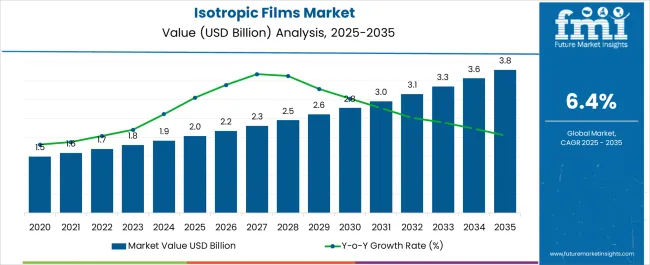
| Metric | Value |
|---|---|
| Isotropic Films Market Estimated Value in (2025 E) | USD 2.0 billion |
| Isotropic Films Market Forecast Value in (2035 F) | USD 3.8 billion |
| Forecast CAGR (2025 to 2035) | 6.4% |
The Isotropic Films market is experiencing steady growth, driven by the increasing demand for high-performance films across packaging, electronics, and industrial applications. Rising adoption is being supported by the need for materials that provide uniform mechanical and thermal properties, dimensional stability, and excellent optical clarity. Technological advancements in film manufacturing, including improved polymer processing and coating techniques, are enhancing product performance and widening application possibilities.
The market is further influenced by growing consumer preference for lightweight, sustainable, and energy-efficient materials in packaging and industrial sectors. Regulatory compliance for food contact, safety standards, and environmental sustainability is increasing the adoption of high-quality isotropic films. The integration of advanced materials into applications requiring precision and durability is supporting overall market growth.
As industries continue to focus on efficiency, product longevity, and compliance, the demand for isotropic films with tailored properties is expected to expand, positioning the market for sustained growth over the next decade Continuous innovation in material formulation, thickness optimization, and performance enhancement is expected to drive market expansion.
The isotropic films market is segmented by material type, thickness, end use, and geographic regions. By material type, isotropic films market is divided into Polystyrene (PS), Polypropylene (PP), Polyethylene Terephthalate (PET), Polyethylene (PE), Bi-Axially Oriented Polyester, and Others. In terms of thickness, isotropic films market is classified into Up To 15 Microns, 15 To 20 Microns, and Above 20 Microns. Based on end use, isotropic films market is segmented into Food Industry, Yoghurts, Desserts, Flavoured Dairy Products, Mineral Water, Instant Soups, Juice, Chemical Industry, and Others. Regionally, the isotropic films industry is classified into North America, Latin America, Western Europe, Eastern Europe, Balkan & Baltic Countries, Russia & Belarus, Central Asia, East Asia, South Asia & Pacific, and the Middle East & Africa.
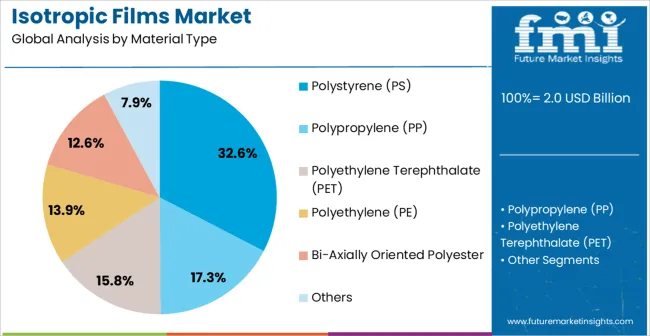
The polystyrene (PS) material type segment is projected to hold 32.6% of the market revenue in 2025, establishing it as the leading material type. Its growth is driven by the inherent properties of PS, including excellent transparency, rigidity, and ease of processing, which make it suitable for diverse applications in packaging, electronics, and industrial products. PS films provide high dimensional stability and compatibility with printing and coating processes, enhancing their versatility.
Cost-effectiveness, combined with scalability in production, supports widespread adoption by manufacturers. The ability to maintain uniform performance across varying thicknesses further reinforces its market position.
Continuous improvements in polymer synthesis and film extrusion techniques have increased product reliability and quality As demand grows for lightweight, durable, and versatile films in multiple end-use industries, PS is expected to maintain its leading share, supported by its adaptability, consistent performance, and strong presence across commercial applications.
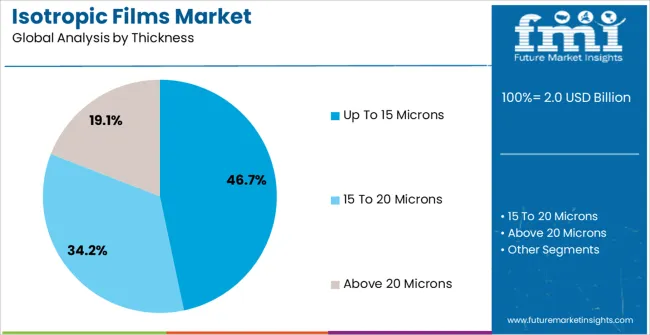
The up to 15 microns thickness segment is anticipated to account for 46.7% of the market revenue in 2025, making it the leading thickness category. Its prominence is being driven by the balance it provides between material strength, flexibility, and processability, which is critical for packaging, lamination, and specialty industrial applications. Thinner films allow for reduced material usage while maintaining mechanical and optical performance, which lowers costs and improves efficiency.
Precision in manufacturing ensures consistent thickness tolerances and quality, making it suitable for high-performance applications requiring uniformity and stability. Growing adoption of sustainable packaging solutions and lightweight films in consumer products has reinforced demand for this thickness range.
The combination of efficiency, reliability, and adaptability has strengthened its position as the preferred thickness segment As industries continue to prioritize performance, cost optimization, and sustainability, the up to 15 microns thickness segment is expected to remain the dominant category, supporting overall market growth.
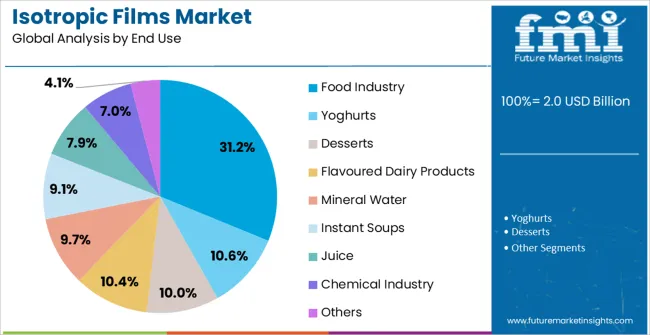
The food industry segment is expected to hold 31.2% of the market revenue in 2025, establishing it as the leading end-use category. Growth is being driven by the increasing demand for high-quality, safe, and durable packaging films that ensure product protection, extend shelf life, and maintain food safety standards. Isotropic films provide excellent barrier properties, transparency, and mechanical strength, making them ideal for packaging perishable and processed food items.
Compliance with regulatory standards related to food contact materials further supports adoption. Manufacturers benefit from the films’ processability in thermoforming, lamination, and flexible packaging applications. The growing preference for lightweight and recyclable packaging solutions has further accelerated adoption in the food sector.
As consumer demand for fresh, safe, and visually appealing food products rises, isotropic films are increasingly being leveraged to meet packaging and safety requirements Continued innovation in film formulations and sustainable packaging solutions is expected to sustain the food industry segment’s leading market position.
The packaging industry is growing throughout the globe due to rising demand for packed foods. Isotropic films have physical properties such as strength, elasticity, etc. uniformly in all the directions. Isotropic films ensure that the product is safe from outer and inner effects which increase the chance of degradation of food products. Isotropic films avoid the infusion of gases including oxygen and water vapour.
The isotropic film is used for barrier flexible packaging because of its outstanding protection and freshness maintain-ability for long-term of the product. The excellent flex crack resistance and superior gloss properties of these isotropic films and their ability to preserve the products for a longer period makes them a preferable choice in the food industry.
Isotropic films deliver excellent thermal and dimension stability and it is the perfect solution for efficient, functional and attractive packaging based on low costs and inventive approaches. Isotropic films is used as a lid, which is the most visible surface to the consumer and used for packaging of yogurts, flavoured dairy products, instant noodle dishes, desserts etc.
For providing better protection to food, isotropic films gains popularity in the market and its market expected to grow during the forecast period.
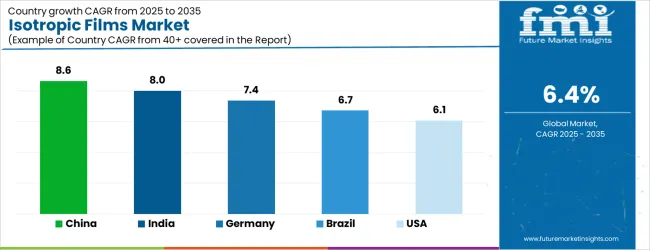
| Country | CAGR |
|---|---|
| China | 8.6% |
| India | 8.0% |
| Germany | 7.4% |
| Brazil | 6.7% |
| USA | 6.1% |
| UK | 5.4% |
| Japan | 4.8% |
The Isotropic Films Market is expected to register a CAGR of 6.4% during the forecast period, exhibiting varied country level momentum. China leads with the highest CAGR of 8.6%, followed by India at 8.0%. Developed markets such as Germany, France, and the UK continue to expand steadily, while the USA is likely to grow at consistent rates. Japan posts the lowest CAGR at 4.8%, yet still underscores a broadly positive trajectory for the global Isotropic Films Market. In 2024, Germany held a dominant revenue in the Western Europe market and is expected to grow with a CAGR of 7.4%. The USA Isotropic Films Market is estimated to be valued at USD 732.0 million in 2025 and is anticipated to reach a valuation of USD 732.0 million by 2035. Sales are projected to rise at a CAGR of 0.0% over the forecast period between 2025 and 2035. While Japan and South Korea markets are estimated to be valued at USD 95.9 million and USD 70.3 million respectively in 2025.
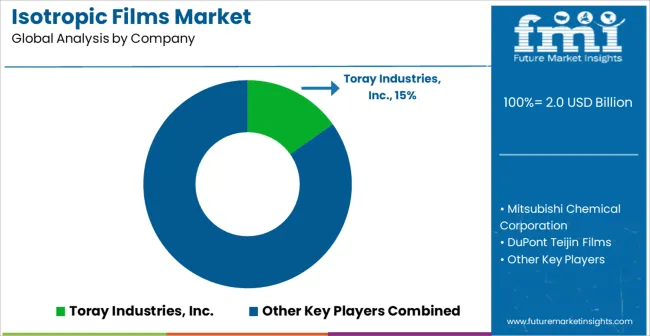
| Item | Value |
|---|---|
| Quantitative Units | USD 2.0 Billion |
| Material Type | Polystyrene (PS), Polypropylene (PP), Polyethylene Terephthalate (PET), Polyethylene (PE), Bi-Axially Oriented Polyester, and Others |
| Thickness | Up To 15 Microns, 15 To 20 Microns, and Above 20 Microns |
| End Use | Food Industry, Yoghurts, Desserts, Flavoured Dairy Products, Mineral Water, Instant Soups, Juice, Chemical Industry, and Others |
| Regions Covered | North America, Europe, Asia-Pacific, Latin America, Middle East & Africa |
| Country Covered | United States, Canada, Germany, France, United Kingdom, China, Japan, India, Brazil, South Africa |
| Key Companies Profiled | Toray Industries, Inc., Mitsubishi Chemical Corporation, DuPont Teijin Films, SKC Co., Ltd., Kolon Industries, Inc., Jindal Poly Films Ltd., Polyplex Corporation Ltd., Uflex Ltd., Cosmo Films Ltd., Taghleef Industries, Treofan Group, Innovia Films, and Sealed Air Corporation |
The global isotropic films market is estimated to be valued at USD 2.0 billion in 2025.
The market size for the isotropic films market is projected to reach USD 3.8 billion by 2035.
The isotropic films market is expected to grow at a 6.4% CAGR between 2025 and 2035.
The key product types in isotropic films market are polystyrene (ps), polypropylene (pp), polyethylene terephthalate (pet), polyethylene (pe), bi-axially oriented polyester and others.
In terms of thickness, up to 15 microns segment to command 46.7% share in the isotropic films market in 2025.






Our Research Products

The "Full Research Suite" delivers actionable market intel, deep dives on markets or technologies, so clients act faster, cut risk, and unlock growth.

The Leaderboard benchmarks and ranks top vendors, classifying them as Established Leaders, Leading Challengers, or Disruptors & Challengers.

Locates where complements amplify value and substitutes erode it, forecasting net impact by horizon

We deliver granular, decision-grade intel: market sizing, 5-year forecasts, pricing, adoption, usage, revenue, and operational KPIs—plus competitor tracking, regulation, and value chains—across 60 countries broadly.

Spot the shifts before they hit your P&L. We track inflection points, adoption curves, pricing moves, and ecosystem plays to show where demand is heading, why it is changing, and what to do next across high-growth markets and disruptive tech

Real-time reads of user behavior. We track shifting priorities, perceptions of today’s and next-gen services, and provider experience, then pace how fast tech moves from trial to adoption, blending buyer, consumer, and channel inputs with social signals (#WhySwitch, #UX).

Partner with our analyst team to build a custom report designed around your business priorities. From analysing market trends to assessing competitors or crafting bespoke datasets, we tailor insights to your needs.
Supplier Intelligence
Discovery & Profiling
Capacity & Footprint
Performance & Risk
Compliance & Governance
Commercial Readiness
Who Supplies Whom
Scorecards & Shortlists
Playbooks & Docs
Category Intelligence
Definition & Scope
Demand & Use Cases
Cost Drivers
Market Structure
Supply Chain Map
Trade & Policy
Operating Norms
Deliverables
Buyer Intelligence
Account Basics
Spend & Scope
Procurement Model
Vendor Requirements
Terms & Policies
Entry Strategy
Pain Points & Triggers
Outputs
Pricing Analysis
Benchmarks
Trends
Should-Cost
Indexation
Landed Cost
Commercial Terms
Deliverables
Brand Analysis
Positioning & Value Prop
Share & Presence
Customer Evidence
Go-to-Market
Digital & Reputation
Compliance & Trust
KPIs & Gaps
Outputs
Full Research Suite comprises of:
Market outlook & trends analysis
Interviews & case studies
Strategic recommendations
Vendor profiles & capabilities analysis
5-year forecasts
8 regions and 60+ country-level data splits
Market segment data splits
12 months of continuous data updates
DELIVERED AS:
PDF EXCEL ONLINE
Anisotropic Conductive Liquid Paste Market Size and Share Forecast Outlook 2025 to 2035
TPE Films and Sheets Market Size and Share Forecast Outlook 2025 to 2035
Breaking Down PCR Films Market Share & Industry Positioning
PCR Films Market Analysis by PET, PS, PVC Through 2035
LDPE Films Market
Card Films Market
Mulch Films Market Size and Share Forecast Outlook 2025 to 2035
Nylon Films for Liquid Packaging Market from 2024 to 2034
Vinyl Films Market
MDO-PE Films Market Analysis by Cast Films and Blown Films Through 2035
Edible Films and Coatings Market Growth - Trends & Forecast 2025 to 2035
Market Share Breakdown of Edible Films and Coatings
Retort Films Market
Tobacco Films Market Size and Share Forecast Outlook 2025 to 2035
Gelatin Films Market Size and Share Forecast Outlook 2025 to 2035
Lidding Films Market Size and Share Forecast Outlook 2025 to 2035
Optical Films Market Size and Share Forecast Outlook 2025 to 2035
Stretch Films Market Outlook - Size, Demand & Industry Trends 2025 to 2035
Protein Films Market from 2024 to 2034
PE Foam Films Market

Thank you!
You will receive an email from our Business Development Manager. Please be sure to check your SPAM/JUNK folder too.
Chat With
MaRIA